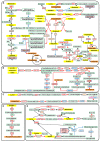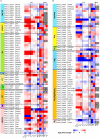Amino Acid Catabolism During Nitrogen Limitation in Phaeodactylum tricornutum
- PMID: 33408729
- PMCID: PMC7780933
- DOI: 10.3389/fpls.2020.589026
Amino Acid Catabolism During Nitrogen Limitation in Phaeodactylum tricornutum
Abstract
Diatoms can accumulate high levels of triacylglycerols (TAGs) under nitrogen depletion and have attracted increasing attention as a potential system for biofuel production. In Phaeodactylum tricornutum, a model diatom, about 40% of lipid is synthesized from the breakdown of cellular components under nitrogen starvation. Our previous studies indicated that carbon skeletons from enhanced branched-chain amino acid (BCAA) degradation under nitrogen deficiency contribute to TAG biosynthesis in P. tricornutum. In this review, we outlined the catabolic pathways of all 20 amino acids based on the genome, transcriptome, proteome, and metabolome data. The contribution of these amino acid catabolic pathways to TAG accumulation was also analyzed.
Keywords: amino acid; catabolism; diatom; nitrogen; triacylglycerols.
Copyright © 2020 Pan, Hu, Yu, Li, Huang and Hu.
Conflict of interest statement
The authors declare that the research was conducted in the absence of any commercial or financial relationships that could be construed as a potential conflict of interest.
Figures


Similar articles
-
Methylcrotonyl-CoA Carboxylase Regulates Triacylglycerol Accumulation in the Model Diatom Phaeodactylum tricornutum.Plant Cell. 2014 Apr;26(4):1681-1697. doi: 10.1105/tpc.114.124982. Epub 2014 Apr 25. Plant Cell. 2014. PMID: 24769481 Free PMC article.
-
Metabolome Analysis Reveals Betaine Lipids as Major Source for Triglyceride Formation, and the Accumulation of Sedoheptulose during Nitrogen-Starvation of Phaeodactylum tricornutum.PLoS One. 2016 Oct 13;11(10):e0164673. doi: 10.1371/journal.pone.0164673. eCollection 2016. PLoS One. 2016. PMID: 27736949 Free PMC article.
-
3-Hydroxyisobutyryl-CoA hydrolase involved in isoleucine catabolism regulates triacylglycerol accumulation in Phaeodactylum tricornutum.Philos Trans R Soc Lond B Biol Sci. 2017 Sep 5;372(1728):20160409. doi: 10.1098/rstb.2016.0409. Philos Trans R Soc Lond B Biol Sci. 2017. PMID: 28717019 Free PMC article.
-
Current trends to comprehend lipid metabolism in diatoms.Prog Lipid Res. 2018 Apr;70:1-16. doi: 10.1016/j.plipres.2018.03.001. Epub 2018 Mar 7. Prog Lipid Res. 2018. PMID: 29524459 Review.
-
Modelling metabolism of the diatom Phaeodactylum tricornutum.Biochem Soc Trans. 2015 Dec;43(6):1182-6. doi: 10.1042/BST20150152. Biochem Soc Trans. 2015. PMID: 26614658 Review.
Cited by
-
Production of safe cyanobacterial biomass for animal feed using wastewater and drinking water treatment residuals.Heliyon. 2024 Jan 26;10(3):e25136. doi: 10.1016/j.heliyon.2024.e25136. eCollection 2024 Feb 15. Heliyon. 2024. PMID: 38322884 Free PMC article.
-
Metabolomic Insights of the Effects of Bacterial Algicide IRI-160AA on Dinoflagellate Karlodinium veneficum.Metabolites. 2022 Apr 1;12(4):317. doi: 10.3390/metabo12040317. Metabolites. 2022. PMID: 35448504 Free PMC article.
-
Integration of Epigenome and Lactylome Reveals the Regulation of Lipid Production in Nannochloropsis oceanica.J Agric Food Chem. 2024 Jun 6;72(24):13785-800. doi: 10.1021/acs.jafc.4c01807. Online ahead of print. J Agric Food Chem. 2024. PMID: 38842303 Free PMC article.
-
The Transition Toward Nitrogen Deprivation in Diatoms Requires Chloroplast Stand-By and Deep Metabolic Reshuffling.Front Plant Sci. 2022 Jan 18;12:760516. doi: 10.3389/fpls.2021.760516. eCollection 2021. Front Plant Sci. 2022. PMID: 35126407 Free PMC article.
-
A shotgun metagenomic analysis of the fecal microbiome in humans infected with Giardia duodenalis.Parasit Vectors. 2023 Jul 18;16(1):239. doi: 10.1186/s13071-023-05821-1. Parasit Vectors. 2023. PMID: 37464386 Free PMC article.
References
-
- Admiraal W., Peletier H. (1979). Influence of organic compounds and light limitation on the growth rate of estuarine benthic diatoms. Br. Phycol. J. 14 197–206. 10.1080/00071617900650211 - DOI
Publication types
LinkOut - more resources
Full Text Sources

